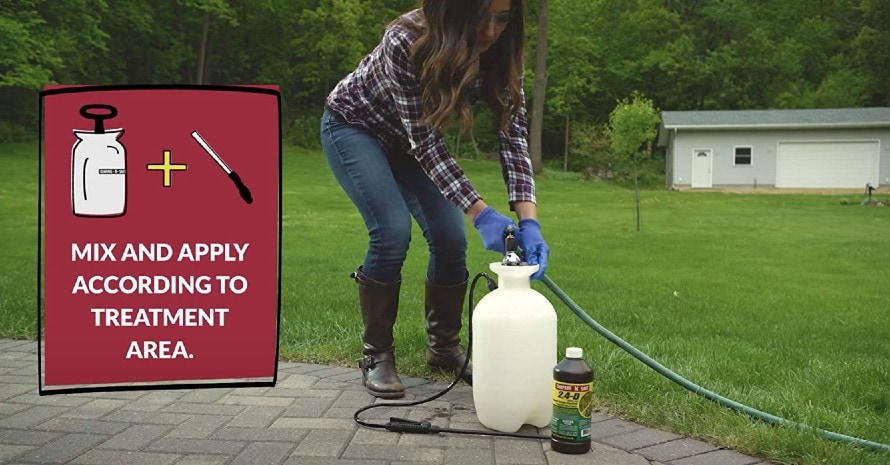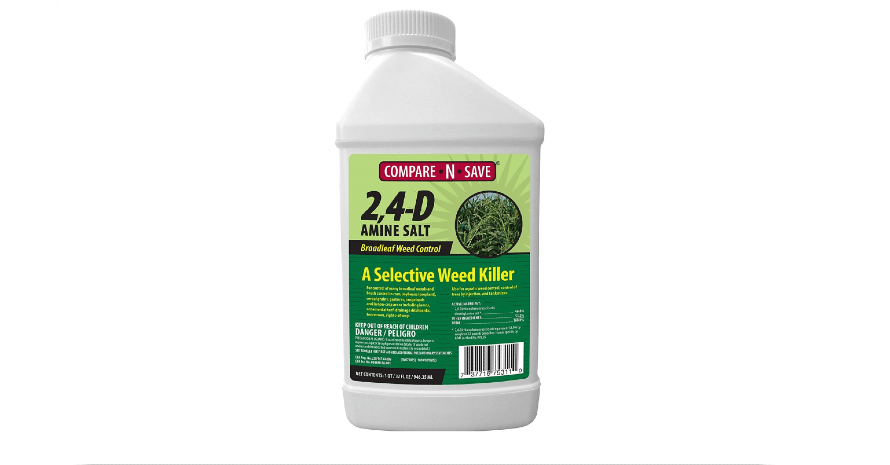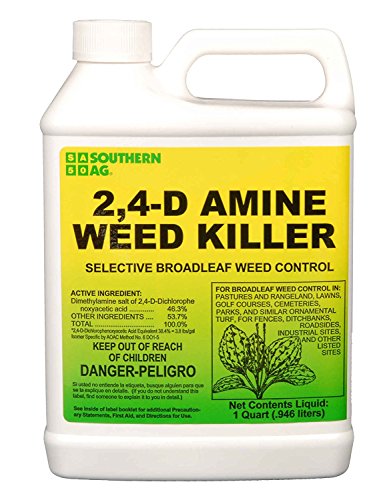2,4-D is neither a new cinema format nor the next cute robot from an upcoming Star Wars installment. Its wars are earthbound – in all the meanings, as 2,4 – D is a weed-killing agent. Since 1945, it’s been widely used for homes and farms, parks, and golf fields to eradicate weeds and leave more space for cereals and other cultural grasses.
Though it went commercial the same year as the notorious DDT, it’s still considered safe for most use cases. Still, it requires some precautions when being applied. So, let’s talk about how safe or dangerous 2,4-D might be, and how to use 2,4-D weed killer, and what effect to expect from it. Reviews of commercially available 2.4-D herbicides are attached.
Affiliate links and images placed from the Amazon Product Advertising API on 2025-11-12
Buyer’s Guide on 2,4-D Based Herbicides
If you are entering the world of today’s yard and garden care, there is a lot to know. Most things you need are printed on labels. But some background is still necessary to understand what it means – a particular sort of literacy. 2,4-D stands for “2,4-Dichlorophenoxyacetic acid”. You can memorize it as a verbal alcohol tester (actually, any chemical term long enough works as one). But when speaking herbicides, “2.4-D” is quite enough. So let’s skip the sophisticated chemistry and jump to the core.
Trivia on 2,4-D: some must- knows
Like many inventions making our everyday life easier, 2,4-D was developed during World War II as a sort of weapon. Now, 2,4-D is widely used by various herbicide manufacturers, as its patent has expired long ago. Generic 2,4-D products are popular, and the labels wear the name proudly.
So what does 2.4-D kill? The answer is strange as we look at its military backstory. Its initial meaning was to extinguish the enemy’s cereal crops. Of course, it had to be reworked entirely for civil purposes, so the commercial version that became available as soon as 1945 left cereals intact and impacted broadleaf weeds instead.
Its impact is very selective. What weeds does 2,4-D kill? The hit list includes clover, dandelions, chickweed, plantain, but not grasses with narrow leaves. Knowing this, you will see that the answer to Does 2,4-D kill crabgrass? It is definitely No. But its selective effect is just the reason it’s still so popular.
2,4-D: is it safe for grass, animals, and humans?
Special care was taken to make 2,4-D safe on humans and animals. So the product does not absorb through skin or lungs. Even when swallowed, it is usually going through, not staying in any tissues of humans or other animals.
The matter is that, though today’s commercial herbicides are tested and certified, it’s not only 2,4-D they contain. The additions may differ, so it’s still better to avoid contact while using 2,4-D on lawns. And, of course, you better keep your kids and pets away during the procedures.
How to apply 2,4-D against weeds
 Usually, the instruction on using 2,4-D Weed Killer is printed on the label (or on an included instruction). The general method is to mix it with water and apply IT directly on the plants you want to kill (right onto the leaves, as the agent is absorbed through them and spreads to the meristems).
Usually, the instruction on using 2,4-D Weed Killer is printed on the label (or on an included instruction). The general method is to mix it with water and apply IT directly on the plants you want to kill (right onto the leaves, as the agent is absorbed through them and spreads to the meristems).
Then it causes uncontrollable growth of some parts, which causes the plant to die. Its selective effect means you don’t have to worry if any drops hit the wrong plants. Because of this way of acting, the best time to apply 2,4-D is while the weeds are still young and the most sensitive.
As your lawn starts getting green in the spring, you can tell whether it’s infiltrated with weeds. As soon as you can detect them (it usually takes about six weeks after the seeding), that’s when to spray 2.4-D on the lawn. Select the day when the weather is warmer, as it may fail at low temperatures (under 65°) but works great when it’s hotter, about 75-80°.
The instructions on how to mix 2,4-D Weed Killer with water are included with any product. As the concentration may differ, and so does the volume, there are no generic recommendations but following the one included.
How long should I apply 2,4-D?
Every herbicide takes some time to take effect. As for 2,4-D, it starts affecting weeds within hours after the initial application. Sometimes the result is visible, so you can see disproportionate growth of the weed (that finally kills it).
It takes just one séance to kill them all (but don’t miss a single one)! It’s not recommended to use 2,4-D on your lawn more often than twice a year. Some products, though, imply that they should be applied ten days again after the first use.
How long does 2,4-D take to work on the selected weeds? The first effects are seen within 8-9 hours after you apply it in the perfect world. In real life, it may take up to two-three days to see the effects you want. Don’t forget to remove the remains of dead weeds from your lawn after the work is done.
A more frequent question is how long 2,4-D weed killer lasts in the soil. Little of it should remain at all, as it’s absorbed by the weeds if applied correctly. Its half-life is estimated at up to 14 days, though, of course, its concentration becomes safe long before that if not overused.
Alternatives to 2,4-D
Though 2.4-D is not as unsafe as other herbicides invented at the same time, neither is it completely safe on humans, with some toxic effects reported. Yes, there are alternatives to it claimed to be safer and… ehhh… greener. Some of them are natural and traditional, as they were invented way before 2,4-D. They include:
- Boiling water. It really kills weeds fast. The problem is that it’s easy to harm anything with it, including grass, cereals, ants, worms – whatever.
- Saline solution. It should be used with even more caution, as salting soil makes it unlivable.
- Lemon juice. Natural, easy to find, quite deadly. Give them a lemon – literally!
All of these natural alternatives, though, are great for local usage only. If you need to save large areas, 2,4-D is still the first thing to consider.
The 3 Best 2,4-D Weed Killer Herbicides Reviewed
When it comes to commercially available herbicides based on 2,4-D, they are way more different than one could expect from products using the same agent for their work. Still, not all of them are made equal. Some are acting more roughly and efficiently, and some are safer and more pleasant to use, and so on. Here are the three products I consider the worthiest.
1. Southern Ag Amine 2,4-D WEED KILLER: The Top Pick
Affiliate links and images placed from the Amazon Product Advertising API on 2025-11-12
Manufactured by a well-known Southern Agricultures, this is a decent weed killer in a 1-quart bottle. They say it takes from one to four pints per acre to extinguish the broadleaf weeds, depending on their concentration. To mix it right, you need to put 2-3 tablespoons into a container of 3-5 gallons. Given its concentration (46.3% 2,4-D), it’s reasonable to sell it like this and then dilute it.
This mixture is said to be enough for covering 1,000 square feet. Of course, in real life, it depends on how strong the infiltration is. If you don’t add enough water, though, you risk damaging other plants with it.
This weed killer’s effect can be observed in two weeks if applied correctly (as described above). You will see broadleaf weeds getting brown and eventually die. Some recommend adding a little soap into the mix, so it spreads more evenly. I haven’t tried it yet, though, but it works well for me when applied to the book.
- Easy to mix and apply;
- Good package for large areas;
- Kills most weeds;
- Decent price.
- May damage grass if misused;
- Works slower than one might expect;
- Mixing instructions are not printed on the label.
2. PBI GORDON 2,4-D Amine Weed Killer: The Premium Pick
Affiliate links and images placed from the Amazon Product Advertising API on 2025-11-12
While other manufacturers offer their own compositions, PBI Gordon offers the clearest 2,4-D weed concentrate with no additions. This makes it the simplest product around and thus the best to use (who said “blue meth”?) It still needs to be diluted – 2 oz of the concentrate per 1 gallon of water. To make it last, some add soap – as I said, it’s quite a common trick.
This exact product is available in various packages, including 1 and 2.5 gallons. The latter option will probably be used for huge areas. So the product is ready for manual application as well for aerial and ground equipment. As you see, the ratios are similar to other products, as the concentration is about the same.
The pro of this product is its clarity. The one-ingredient formula lets you add other surfactants than soap to make it stick on leaves and invade them. That’s what makes it different from the others, but experienced green thumbs can fully appreciate this advantage.
- Simple formula
- High concentration
- Clear instructions on the label
- Made in the U.S.
- May work slower than you expect.
3. Compare-N-Save 2-4-D Amine Broadleaf Weed Killer: Runner-Up Pick

The name implies this is a budget-friendly product, way cheaper than rivals. When you compare the price to the previous one, you may find they are about the same. This one also comes in 1-quart plastic bottles, and both can be bought for about $20-25. The concentration is slightly higher (46.8% vs 46.3%), but it’s not that significant.
The mixing instruction is also similar: take up to 3 tablespoons of it, dilute 1 gallon of water, and process about 1 acre. The effect is also similar, providing you with a weed-free area in about two weeks.
The product is very much like the previous one. I did not find any significant difference between these two (though I applied them in different years on the same lawn). The advantage that’s especially important for amateurs is the complete instruction on diluting and using it with the bottle.
- High concentration;
- Easy to use after other products;
- Full instruction included;
- Quite affordable.
- Easy to overuse;
- Not as profitable as the name implies.
The Acid Works
It’s hard to recommend among goods that bear very little difference due to the same active agent. Still, these above have established themselves as working, quite safe, and easy to handle weed-killers. Though 2,4-D’s reputation might have been spoiled with its usage in the infamous Agent Orange, by itself, it’s still among the safest herbicides, being not as versatile as one would wish. But it is doing its job well.
If you want to share your experience with it, write it down in the comments. Or share it to your SM page to talk about it with your Facebook or Twitter fellows. The discussion is still open.



